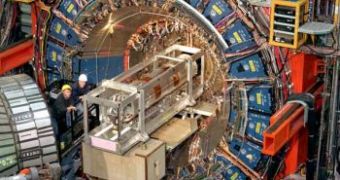At the International Conference on High Energy Physics - ICHEP in Paris, scientists from Fermilab announced yesterday that they might soon see the Higgs boson, as they have reduced the possible sizes of the particle.
The so-called “God particle”'s existence was suggested by British theoretical physicist Professor Peter Higgs, as a possible answer to why some particles have mass and others don't, LiveScience specifies. Ever since, scientists have only speculated on its existence as the Higgs boson has never been found. Experiments at the Large Hadron Collider at CERN, in Switzerland, and at the Tevatron Collider at Fermilab near Chicago might just bring scientists one step closer to seeing the Higgs boson.
Fermilab scientists have cut Higgs boson’s possibles mass range by a quarter. Following the Standard Model of Particles and Forces, the Higgs particle should weigh between 114 and 185 GeV/c2 (GeV/c2 being a measure of mass and stands for gigaelectronvolts divided by the speed of light squared — 100 GeV/c2 is equivalent to 107 times the mass of a proton). After Fermilab's experiments the higgs boson can no longer have a mass between 158 and 175 GeV/c2.
It took nine years and more than 500,000 billion collisions inside the Tevatron collider for scientists to get to this result. Stefan Soeldner-Rembold of the University of Manchester in England said: “Our latest result is based on about twice as much data as a year and a half ago. As we continue to collect and analyze data, the experiments will either exclude the Standard Model Higgs boson in the entire allowed mass range or we'll go on to see first hints of its existence. There is less and less room for the Higgs boson to hide now.”
These results along with scientists' work at the LHC help reduce places where the particle can be found. John Womersley of the Science and Technology Facilities Council in England an founder of the work at the LHC said: “There are important pieces missing in our understanding of the basic building blocks of the universe, and these results are an important step in learning how our universe works and why it exists.”
Scientists at Fermilab would like to see the Tevatron running another three years, until 2014, especially now that the LHC will shut down for 15 months for repairing and they would have a considerable advantage in discovering the Higgs boson. A few European physicists also sustain the idea, like Guido Tonelli of the University of Pisa in Italy, spokesperson for the 3800-member team working on the CMS particle detector at CERN. “In an ideal world, I think it would be good to have the Tevatron running in parallel with the LHC,” he says. “For the next 2 or 3 years, the two machines will be complementary.”
Except that Melvyn Shochet, physicist at the University of Chicago in Illinois and chair of the U.S. government's High Energy Physics Advisory Panel, stresses that Fermilab officials live very much in a world of limited resources. “I don't see anybody coming along with a check for the $100 million or whatever it costs to run the Tevatron for 3 years,” he reasons. “So Fermilab has to consider what it's going to give up” to run the Tevatron, quotes ScienceNow.

 14 DAY TRIAL //
14 DAY TRIAL //